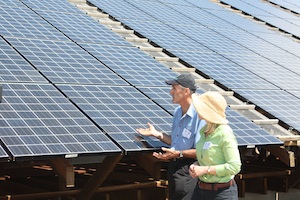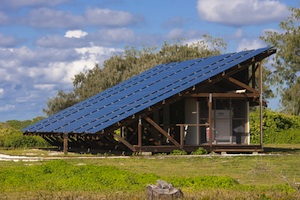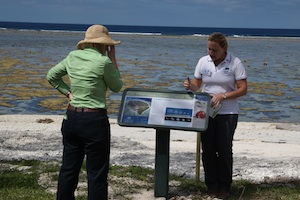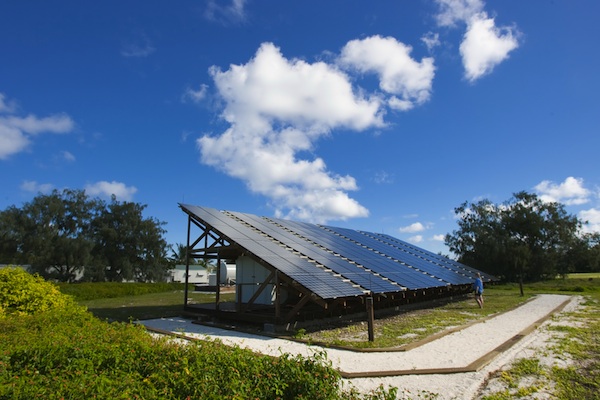Clean Energy for Ecotourism

© Lady Elliot Island Eco Resort. Hybrid Solar Power Station Launch 29 in the context of the Paris Climate Conference 2009.
Lady Elliot Island is located at the southern tip of the Great Barrier Reef World Heritage Site. Recommended publications (IUCN Category II).
guidelines, water desalination and complementary demand management strategies, the Lady Elliot Island Eco Resort now runs on approximately 40% energie rinnovabili, with a goal to operate on 100% renewables in the next three years.
Promoting energy efficiency
The resort has undergone a series of transformations over the years to improve the visitor experience while at the same time reducing its energy usage.
The Resort operates under an Environmental Management System approved by the Great Barrier Reef Marine Park Authority. Under this system, the Resort has an Energy Management Plan. This plan helps the Resort to stay focused on reducing energy consumption and increasing the amount of energy supplied by renewables.
Following an energy audit in consultation with the Great Barrier Reef Marine Park Authority, the Resort introduced a number of low-cost, energy saving measures which resulted in an initial 20-25% reduction in energy costs. The resort staff identified the need for further load reduction and energy savings to maximise the overall effectiveness of the solar hybrid system. The audit also identified the opportunity to develop a hybrid off-grid power station to reduce carbon emissions, Photo Gallery.
Using renewable energy
The resort decided to establish a hybrid power station. The power station was funded as a joint venture between Lady Elliot Island Eco Resort and the Australian Governments Renewable Remote Power Generation Programme.
There was much effort put into design to ensure the structure of the power station had the smallest possible environmental footprint. Normal solar farms are spread out low in multiple rows on the ground. The Resort aimed to reduce the size of the area so the solar panels were contained into a single structure, with the space underneath used to build the rest of the station. This compact design reduced the footprint by more than half and resulted in an unusual design.
Photo Gallery, construction and running of the system.
In 2005, when the current owners assumed responsibility for the resort operation, the resort was using 550 litres per day of diesel (200,000 litres per year) to produce power using 220 kilowatt diesel generators running 24 hours per day. After four subsequent upgrades to improve how the resort produces power, the resort is now producing renewable energy from 188 solar panels that produce 43 kilowatts (kW) of power and 45kW of battery storage. This has reduced generator run time to 10/11 hours per day, therefore reducing daily fuel usage to approximately 100 litres per day. The system now includes three battery banks with 72 cells, three inverters and a new generator a quarter the size of the resort’s original units. Photo Gallery 133 kW, and is housed in a timber-framed structure. The structure is positioned for maximum ventilation and shading of electronics and batteries, and is a self-supporting, ballasted structure, eliminating the need for concrete slab or ground screws.
The Resort would like to add wind power to their renewable energy production but this will require impact assessment to ensure the wind generators are able to function without disturbing the numerous nesting seabirds that utilise the island.
The resort now enjoys a 60% reduction in fuel consumption and emissions, with this expected to increase further as additional solar panels or wind generators are added over time. Photo Gallery.
Interpretive tours are conducted for guests and educational groups. Tour topics include the effects of climate change on a coral cay, the activities that Lady Elliot Island Eco Resort is doing to help slow down climate change, calculating carbon emissions and touring the hybrid solar power station to discover how the resort has managed to substantially reduce carbon emissions on the island. The island’s history is also explored by touring the historic generator room which still houses the old diesel generators.
Lessons learned and replicability
As a leader in the introduction of new technologies on offshore islands, Photo Gallery.
The Resort has found that the most controversial and challenging part of making the switch to renewables was convincing guests and staff to focus on ensuring they use as little power as possible.
Through this installation, not only are reductions in fuel consumption and emissions an immediate result, but there is a greater awareness for both people that live on the island and people visiting which will further encourage the integration of sustainable principles. Energy sustainability is promoted to visitors with a take home message of considering energy sustainability options in their own lives, making Lady Elliot’s experience a replicable model beyond the technical solutions used.


















